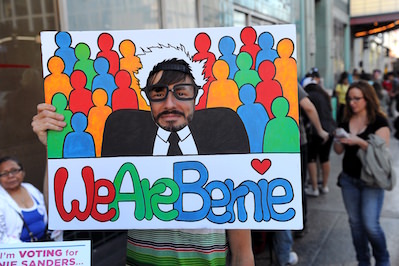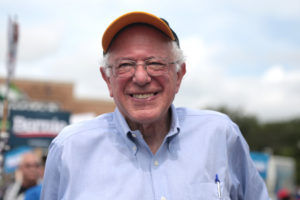No Blues for Bernie in L.A., Where Sanders Backers Are Still Making Happy Music
A Los Angeles rally—defying media pessimism about the Vermont senator's chances against Hillary Clinton—shows upbeat determination and eagerness to tackle the complex delegate process.

Scott Sorensen sticks his face in a sign before a Bernie Sanders rally held in Los Angeles’ Wiltern Theatre on March 23. (Michael Owen Baker / AP)
As I stood in a park amid dead-serious Bernie Sanders volunteers on a recent Saturday afternoon, it occurred to me that the media is missing the real story of his campaign for the Democratic presidential nomination.
There was an upbeat determination — instead of the pessimism reflected in news stories and analyses — at this Sanders rally, in Pan Pacific Park in Los Angeles’ Fairfax district. Basketball was being played at nearby courts, but the Sanders supporters weren’t there for recreation.
Sanders’ double-digit victory in the Wisconsin primary Tuesday showed that his contest with Hillary Clinton is far from over. Still, he trails in national polls and is well behind Clinton in the race for national convention delegates, and the mass media gives him little chance of winning. Take, for example, the New York Times story that more than 15 Sanders associates told reporters he fouled up by not starting out with an aggressive campaign against Clinton. “By the time he caught fire with voters this winter and personally began to believe he could defeat Mrs. Clinton, she was already on her way to building an all but insurmountable delegate lead,” the Times said. The USC Dornsife/Los Angeles Times poll had Clinton leading in California 45 percent to 37 percent as of late March.
The 200 or more people at the Pan Pacific Park rally didn’t seem to consider the lead insurmountable. Rather, they threw themselves into the complicated process of picking Sanders’ delegates. The California’s June 7 primary will decide how many Sanders and Clinton delegates go to the Democratic convention in July. Most of the state’s 548 Democratic delegates will be selected in contests in each of the 53 congressional districts, with 105 at-large delegates going to the candidate who wins the entire state. The rest are well-known politicians favoring either Sanders or Clinton—most of them for Clinton, the establishment favorite.
“An intentionally mysterious process” is how Nathan Fisher, who was instructing the rallygoers on how to participate in the congressional district voting, put it. Fisher is a candidate to be a Sanders delegate in one of the districts, and he’ll have to round up enough friends, relatives and other supporters to be elected.
“Every congressional district must have a full slate of Bernie supporters,” Fisher emphasized. What is important, he added, is to elect delegates who will hit the convention floor “very strong for Sanders.” And he told the group that only registered Democrats can vote. He noted that some Sanders supporters couldn’t stand the Democratic Party. “I know for some people this is a bridge too far, but they register as a Democrat,” he stated.
This process is being repeated throughout the nation for Democrats and Republicans, following rules so complicated—and generally so rigged against outsiders and newcomers—that only experts can understand them. At this stage of the game, the most valuable players are those who understand the twists and turns. If Sanders manages to deny Clinton enough delegates on the first ballot, a contested convention would be thrust into a delegate-by-delegate fight, and victory would go to the smartest, toughest and best organized. That is why Fisher’s presentation was so important.
Joining the volunteers at the park were three organizers just sent to California by Sanders’ national headquarters, joining up with the local volunteers. The volunteers have been working hard, since last year, and don’t want to be ignored by the paid newcomers.
Megan Harris, in charge of Sanders’ Southern California campaign, seemed aware of their concerns. “You folks have already done a ton of work,” she told them. “We’re not going to take over. We’ll work with you and bring you into the national umbrella” and aim for registering 200,000 more Democrats in California.
She and her co-workers, she said, are traveling light, bringing their sleeping bags and looking for volunteers to put them up. “We don’t want to spend all the money on hotel rooms,” she said.
I talked to Montgomery Markland, one of the main organizers of the rally. Markland, who produces video games and movies, was an aide in the Texas Legislature and ran campaigns in that state. “Right now, we are dealing with the problem of getting people to work together,” he said. He was confident that would happen. In the end, he said, Sanders “will be relying on the largest grass-roots organization in history and also the best trained.”
There may have been bigger grass-roots organizations in history, but he’s got a point about the training. I’ve been following these folks for several months and have seen some of them evolve from computer-wary to proficient, tech-oriented workers who can make targeted phone calls from lists sent digitally from campaign headquarters in Vermont.
Such efforts are why the obituaries being written about the Sanders campaign are so premature.
Independent journalism is under threat and overshadowed by heavily funded mainstream media.
You can help level the playing field. Become a member.
Your tax-deductible contribution keeps us digging beneath the headlines to give you thought-provoking, investigative reporting and analysis that unearths what's really happening- without compromise.
Give today to support our courageous, independent journalists.






You need to be a supporter to comment.
There are currently no responses to this article.
Be the first to respond.